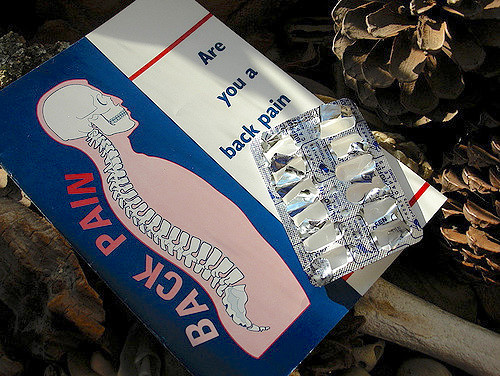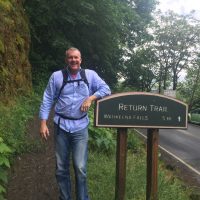
While some people seem comfortable with sharing every bit of pain they experience, I’m generally not one of them.
But pain, if we let it, can be a wise teacher. If we look carefully for the source of our pain, be it physical or emotional, we can learn a lot about ourselves and maybe even others too. My latest lesson with pain began at the end of a lawn mower starter cord.
After a couple of unsuccessful attempts at starting the shiny, red contraption by turning the ignition key, I resorted to the old-fashioned way of starting the ornery beast. On the third pull of the rope, the machine finally roared to life. And simultaneously, I felt the unmistakable pain of a disc exploding in my lower back.
It was unmistakable, because I’ve ruptured two discs in the past and fortunately have had two successful surgical repairs as a result of my misadventures. Now, I’ve had three surgeries. And as I write these words, I’m a little more than three weeks out from it, and I’m hopeful the skill of my surgeon will result in a claim of a third successful surgery.
After starting the mower, I somehow pressed through the pain and got the yard cut. Albeit, it wasn’t my best work. When I was finished, patches of grass I’d missed dotted the landscape like tiny oases of Mother Nature’s refusal to be tamed. I’m sure my neighbors thought the work had been completed by some bespectacled nine-year-old who just wished he was playing a video game.
Over the following few days, a series of MRIs, X-Rays, and CT scans confirmed my own diagnosis, and my doctor promised to see me again Thursday. Only when he had reviewed all of my deductible-based evidence he had amassed would he then offer his thoughts about surgery. In the meantime, he put me on a mixture of medications intended to make me “comfortable.”
But no amount of narcotics was sufficient to make me comfortable prior to that Thursday appointment. And Wednesday morning I awoke in such perfectly exquisite pain—the kind of pain that made attempts to focus on my breath impossible—that I couldn’t get out of the bed. Pain, you see, no matter what the source, has a way of breaking through our efforts to medicate it away—it must be cured at the source. While that’s not always possible, in my case, there was at least the hope of such a remedy.
Since I live alone and am reticent to let people see my pain, be it physical or emotional, I pondered the most dignified way I could get to the Emergency Room. After an hour or so of debating with myself, I called dialed 911. The kind dispatcher wondered if she should stay on the line with me while help was on its way, but I told her I was going to need to crawl to the front door to unlock it. Which I did with the stealth of Gollum muttering “my precious.” It wasn’t a pretty sight, I’m sure. And you’d be surprised at all the things you see when you crawl through your home. But that’s another tale for another day.
When Joe and Charlie arrived, the Emergency Medical Technicians (EMTs), they gently helped me navigate from the bed to the gurney. This was not pleasant. Nor was it dignified. Pain has a way of breaking down our feigned self-assurance—our persona. In truth, I was six-foot-seven and 250 pounds of helplessness, alternately cursing (not at them) and crying out in discomfort.
As a writer, I’m rather proud of how well I managed to string together bits of profanity in a creative symphony of pleading. Nouns became verbs; verbs became adjectives; and adjectives became pronouns in my litany of prayer for both the saved and the damned. But no matter how I cursed or cried out in pain, the EMTs where kind and patient. They will never know the depth of my gratitude.
In a moment of unexpected yet profound comfort, Joe smiled and noted I was hanging off both ends of the gurney, suggesting that I might not fit into the freight elevator. We laughed at that in a kind of macabre amusement. But after a bit of work, and me awkwardly pulling my feet into the gurney, the door finally closed, and we were on our way. Mercifully, the only other witness to my awkward exit from the building that morning were the kind eyes of Kathy, the property manager at my apartment. Passing by her, I tried to remember if I’d paid my rent. (I had.)
So what of my pain? To see me was to know something was wrong, but there was no blood. There were no bruises. No broken or wrapped bones. There was no visible evidence that I was injured beyond the contortions of my face. All I had was the claim of my own distress—just like people who suffer from depression, social anxiety, and a litany of other emotional and mental tribulations.
On the ride to the ER, I worried I would face a skeptical medical staff weary of those poor souls whose addiction drives them again and again to the ER in hopes of a prescription for narcotics. God knows I was hoping for more than that. I wanted the good stuff. The really good stuff that makes the world seem like an effortless place. Hopes of Dilaudid and Valium danced in my brain like joyful children playing in a spring shower.
But what if they didn’t believe me? What if they left me to writhe in pain for hours while some secret society decided if I was worthy of their magical potions. Thankfully, I knew I had insurance, so I reassured myself that such a silly thing would somehow make me seem more worthy. I tried to look at the nurse I met as if didn’t care if I got the meds or not, hoping my feigned indifference would convince them I wasn’t a pill shopper.
Fortunately, I got the medicine I needed. But as the discomfort subsided, I realized how afraid I had been to let anyone see my pain. I hadn’t wanted a friend to drive me to the ER. I didn’t want to be a bother. I hadn’t wanted to seem helpless. I didn’t want people who respect—or at least like me—to see me near tears or hear me cursing as if a demon was being exorcised from a beleaguered soul. While I would gladly have come to the aid of any one of my friends or family who needed such assistance, I just didn’t want to be seen as vulnerable.
In the first week or so following my surgery, I had to rely on people who love me to bring me food, take me to the doctor, remind me not to post selfies on social media while under the influence of pain meds, and tell me the funny and perhaps inappropriate things I said when I was still under the influence of anesthesia.
And after one particularly bad night, when the pain crashed through my sleep like an uninvited, drunken uncle showing up at a family party, I drove myself back to the ER. I was crestfallen when the dismayed doctor told me she couldn’t give me anything without someone to drive me home. Once more I was forced into that vulnerable place. I had been so brave. So determined. I drove myself. But I had to be vulnerable again and called my faithful and kind friend Lisa, who unhesitatingly said she would be there in 20 minutes so I could get the meds and drive me home.
Since the surgery, I’ve even had to let the people who love me clean my apartment. When you have back pain, whatever you drop on the floor stays on the floor. But strangely, all their kindness hasn’t been awkward. It’s been redemptive. By allowing others to help me, I’ve learned some things about myself and something about them too. The experience has continued to reinforce the knowledge of just how rich my life really is—even with my spine that I’d trade for a couple of chickens, a goat, and a nice cheese ball.
The phone calls and texts and messages I’ve received during the monotony of my recovery have been overwhelming. And the friends who have come with a cup of coffee and sat with me, if only for just a few minutes, have made a profound difference in my recovery. It’s been three weeks since that day with the lawn mower, and those same people are still showing their concern for my recovery.
Acute and chronic pain, no matter what kind it might be, are insidious things. They shroud our mind with lies and unearths our deepest fears. They make us wonder if we will ever return to the fragile thing we call “good health.” But I’m learning it is also a teacher. I’m learning not to run from pain. I’m learning not to try to hide it behind a facade of perfection. No, I don’t wander through life asking people to indulge me while I tell them about all my trials and pain. But I’ve widened my circle just a bit more. I’ve let a few more people see what’s really going on inside me. It’s made a big difference in my life. I know it’s scary. Maybe you should try to let your pain teach you those things too.
And if you encounter someone who’s in pain—especially the kind that you just can’t see—maybe you could give them the benefit of the doubt. Maybe you could offer them the assurance you will stay on the phone with them until help arrives. Or you could offer them freedom to cry out or curse, offering them only kind eyes when they do. You could take them a bite to eat, or sit with them over a cup of coffee. You can call them or text them. You don’t have to fix their pain. Just sit with them, being present with them in their pain. You can breathe for them when they can’t do it for themselves.
And if you’re suffering in pain now and maybe looking for someone to talk to, message me. We can get a cup of coffee when I’m back on my feet. Until then, we can chat by phone or swap a few texts.
~
~
~
Author: Jim Owens
Image: Flickr/Tony Hall
Editor: Travis May
Copy Editor: Nicole Cameron
Social Editor: Waylon Lewis










Read 0 comments and reply